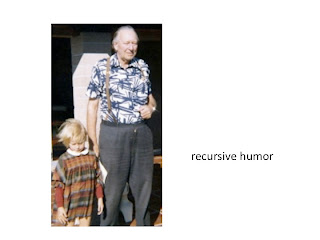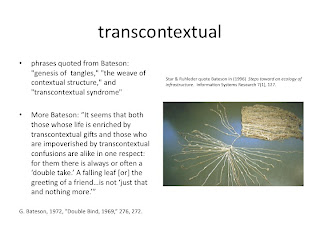===
Clicking slides allows you to see them as a slide show, and to examine each more closely.
===
• SLIDE ONE: TITLE
Good morning! I am Katie King, a professor of Women's Studies at the University of Maryland, College Park, and a Fellow of the Maryland Institute for Technology in the Humanities (MITH). I studied with Gregory Bateson at UC Santa Cruz in the early seventies, and got my PhD there later in the eighties from the History of Consciousness, a program Bateson taught in, briefly before his death. My academic scholarship is located at the intersection of feminist technoscience studies, intersectional digital cultures and media studies, and LGBT Studies. I think of my work nowadays as inside of an emergent feminist transdisciplinary posthumanities, an ecology of knowledge worlds, media, and distributed being.
===
• SLIDE TWO: RECURSIVE
I remember well how, looming large in front of our classroom in the seventies, Bateson would recount one of the several stories that figured those central concepts he positioned, and then, very obviously, repositioned in relation to each other. Working against the "nonsense" children are taught in school – "that the way to define something is by what it supposedly is in itself, not by its relation to other things" – he insisted on the necessity of examining pattern, especially "the pattern which connects." As he strode back and forth, weaving his patterns in motion, gathering many little details to illustrate widely a specific set of ideas, we would sit listening and connecting, responsively pleased that our own details of biography and concern shared with Gregory were now some of the materials figuring in his stories. As this wave of pleasurable connection, of intellectual intimacy, reached its crest, he would turn and face the whole class, look into each person's eyes, and say: "It's all a trick, you know." (Bateson, G. 1979: 8, 17)
===
• SLIDE THREE: INSIDE
Bateson was a master at that three dimensional hinge between what is conscious, what is semi-conscious, maybe tacit, and what is performed at the gut level. AND at the meta indication, if not always explanation, of the “trick” of cybernetic interactivity across the many systems entangled there. He taught us all how to be inside of what we think about, and how to play a role as a companion agency without assuming we run the show.
I think today of media as one ecology embedded among ecosystems in a legacy from Bateson, one entangled with global economies, technological experimentation, and deep-seated appetites in the human brain that actually distribute neurological and hormonal pathways beyond individual human bodies.
Being inside and moved around literally by the very material and conceptual structures you are analyzing and writing about is a kind of self-consciousness only partially available for explicit discussion.
===
• SLIDE FOUR: WE
How we know anything, Bateson famously said, means that in “the pronoun we, I of course included the starfish and the redwood forest, the segmenting egg, and the Senate of the United States.” (Bateson 1979:4) Bateson found himself among people from a range of knowledge worlds as he traveled among communities academic, new age, religious, artistic, and entrepreneurial. Today we use the word transdisciplinary to describe such movements. (Thompson Klein 2004)
What does it take to communicate across such knowledge worlds? One experiment in working this out occurred in the nineties: something we now call transmedia storytelling, which began among the entertainment industries, but has since reshaped knowledge ecologies as they absorb and are absorbed by media systems. In transmedia storytelling distributed, even diverging, authors and audiences morph into makers, gatherers, sharers, demonstrators, across media platforms, creating embedded stories, autonomous in themselves but intensely pleasurable as they are pulled together in correlated activity.
And I am aware of how academic practices of all kinds also are now enlisted in forms of transmedia storytelling. I call these Queer Transdisciplinarities, but not in a move to enlist them in identity politics, although sometimes they very explicitly and quite properly are, inside my own feminist fields of interest and attention. Rather, my point in naming them thus is to watch them “queer the pitch”: they require us to attend to, to learn to be affected by, the political economies of knowledge worlds, to how interlinked now are the economies of entertainment, knowledge laborings, globally restructured academies, governmentalities, and the infrastructures of communication. (King 2011, “Queering the Pitch.”)
===
• SLIDE FIVE: TRANSMEDIA
Transmedia storytelling allows one to both show and tell at the same time: to share a possibly elegant or brief but extensive view while creating opportunities for delving deeper into intensive work done by specific communities of practice, ones with strong interests in rigor and membership, but collected together are revealed to have divergent standards for these.
I modestly offer today my own transmedia story then, one you must seek out: you will have to travel among its platforms, and at each one gather different bits, in order to experience the immersive and transdisciplinary PLAY I have to share with you.
Now you HEAR my talk into the air, SEE my slides offered over the computer, have in your HAND my paper handout to carry away with you, which has both redundant information from the talk and slides, and other information I haven’t time to present, and which direct you to the talk website on the internet I made for you, which stores all of these for later examination, which offers a bibliography, and which has links to more communities of practice, both directly and perpendicularly important to what I am saying, and which also contains playful so-called easter eggs, or unexpected gifts, some linking you to other media on the web, or examples of recursive humor, such as that Gregory slyly slipped by us all. Make a point of clicking the pictures on the website to find some of these!
===
• SLIDE SIX: TRANSDISCIPLINARY
Transdisciplinarity is made up of a Bateson-style PLAY or double consciousness: of the value of, but also the disparities between, on the one hand • intensive communities of practice that, say, strongly differentiate themselves through distinctive methods and evidentiary standards, and which gradually incorporate members only as they come to share or negotiate these; and on the other hand, at a meta level, • extensive gatherings across these, which inspect their distinctiveness without deauthorizing it, but also interconnect knowledges that otherwise would be outside of the units of analysis assumed among intensive investments in rigor.
===
• SLIDE SEVEN: BINDS
Bateson experienced such double consciousness in some of its most innovative forms, as well as in some its most humiliating ones. Not surprisingly communication tangles are something he endured, analyzed, humorously told stories about, and otherwise worked among reflectingly and recursively. His paradigm-altering work on double bind theory considered carefully how “both those whose life is enriched by transcontextual gifts and those who are impoverished by transcontextual confusions are alike in one respect: for them there is often a ‘double take.’ A falling leaf [or] the greeting of a friend…is not ‘just that and nothing more.’” (1972:272)
Double binds are transactions, that is to say, relational, social, and built upon repetition. More than a single or simple contradiction, they are instead an entire system of layered contradictions mobilized over a range of communication channels.
With double binds, abusive practices and just challenging ones are only too easily mistaken for each other when crucial context markers distinguishing one from another are unvoiced or become unrecognizable, contradictory, or fraudulent.
===
• SLIDE EIGHT: TRANSCONTEXTUAL
Such reflective analysis of “the transcontextual syndrome” inspired feminist theorist Susan Leigh Star, who, in a last essay before her sudden death in 2011, defined her concept “boundary objects” as “organic infrastructures” that address “‘information and work requirements’ as perceived locally and by groups that wish to cooperate.” (Star 2010:602; Star & Griesemer 1989, Star & Ruhleder 1996, Bowker & Star 1999)
===
• SLIDE NINE: BOUNDARY
Boundary objects are especially found all through feminist practice, with its projects that are sometimes critical of standard ones, and often attempting to offer alternative practices intentionally perpendicular, working with what other systems have made residual.
I am curious about the relational play between intensive and extensive knowledge practices in transdisciplinarity. I tend to find myself having to justify extensive practices, those of speculative connections, practical coalitions, and trial and error learning; such as one finds in transdisciplinary projects, transmedia storytelling, and alternative practices-in-the-making. These tend to emphasize peripheral participation and the edges of standardized practices.
I like that extensive investigations perpendicularly analyze relative and relational shifts across authoritative and alternative knowledges, and that their displays sometimes work without displacing the intensive work of specific communities of practice. This is that perpendicularity of extensive examination as transcontextual – befriending paradox and recursion and sensitized to double binds.
===
• SLIDE TEN: PLAY
The “rigor” of transcontextual feminist methods comes into play I believe when we welcome that “People often cannot see what they take for granted until they encounter someone who does not take it for granted” (Bowker and Star 1999: 291), and work for an exquisite sensitivity to each horizon of possible resources and infrastructures, local exigencies, and differential memberships.
Bateson-style understandings suggest that PLAY creates its own commentary in itself about itself as an intense and pleasurable interactive dynamism — communicatively social, as well as neurological and hormonal. Such metacommunications are performed by embodied selves at multiple “levels” of organic and social system, some sequentially, some simultaneously. (Bateson 1972, 1980)
Nonabusive PLAY at the very edge of double binds is possible when we note, for example: “My body is reacting as if I am in danger, but really I’m in front of a computer screen.” (Reality? Not.) But Bateson was well aware that not every edge of play is so easily resolved: that transcontextual confusions and gifts arise from situations in which “tangles” remain – in which finding out which bits are active, which bits are context, which bits can be made explicit, which rules are perceptible, which distributed embodiments, cognitions, and infrastructures are in play, matters. And the skills for all this, transcontextual movement without falling apart – are what restructuring academies, nations, and industries call “innovation.”
===
• SLIDE ELEVEN: GRAIN
Extensive exploration works out, in and around grain of detail, noting both • membership and • peripheral participation. Valuing and E-VALUATING simultaneously • intensive knowledge management and • extensive knowledge inspections. Recognizing and rewarding the paradoxical work by • distributed author agencies struggling to contact • distributed, niche, or emergent “audiences” or uses. All this requires both • scoping out: assemblage and infrastructure and • scaling in: closely negotiated disciplinary or other intensive interests.
Transdisciplinary work befriends and experiences a range of academic and other genres of writing, entailment, and analysis, befriends and experiences their consequent and diverging values, sometimes in tacit collaboration, sometimes in perpendicular examination.
===
• SLIDE TWELVE: DYNAMIC
THE LAST SLIDE: Transcontextual feminisms as I have come to understand them, have to scope and scale among ecologies of knowledge. They work to remain curious: about both the passionate affiliations that intensive knowledge work done among close and precise grains of detail require and produce, and also the necessarily recursive and speculative wanderings among knowledge worlds to produce extensive pattern-makings that transdisciplinary work makes possible.
Feminists and Bateson-style systems analysts should find in Susan Leigh Star’s work an inspiration for practices for “growing” boundary objects, for inverting paradigms presuming that first we build consensus and then we can cooperate. Star offers us instead “steps toward an ecology of infrastructure,” those sensitive to anomaly. “Haunting social justice” are, she says, “the battles and dramas between… the standardized and the wild.” (Star 2010:614) A recursive humor makes clear that the concept of boundary object is itself a boundary object….
Thank you.
===
Handout12 Bateson Asilomar
===












